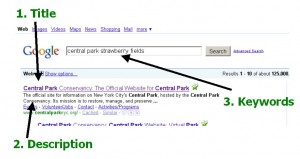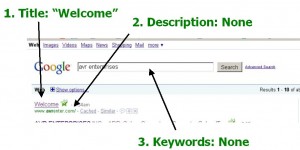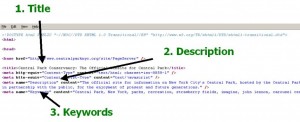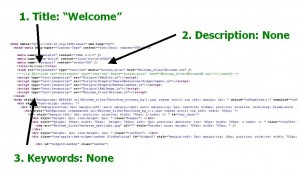SEO copy writing is a foreign concept for too many writers. A shocking number of companies invest in great copy for their Web sites, but miss the last and most basic element: writing great meta-data. Neglecting meta-data–the words and phrases used by search engines to present your content in search results pages–is perhaps the biggest SEO copy writing blunder companies make.
While Google and other search engines use more than meta-data to rank your site, it still plays a key role when it matches the content of your site and if it appeals to humans scanning the results pages. If no one can find your site, no one will read your site copy, no matter how good it is. You can write great copy, rich in keywords and formatted to rank highly in search engines, but if you overlook SEO copy writing with good meta-data, and you are trying to run a marathon with your feet tied together.
Meta-data Triple Crown for Search Engine Optimization (SEO)
Meta-data is the content that search engines use to present your site in search engine results pages (SERP). You can find the meta-data of any site or any Web page by using the “view” command and “page source” or “source” selection in your browser. You’ll then see the source code for the Web page. Within that code you’ll find the three most important meta-data elements of every page of your site:
- Title: <title>whatever your title is</title>
- Description: <meta name=”description” content=”whatever copy you use to describe your site—only 160 characters will show up on most search engines”>
- Keywords: <meta name=”keywords” content=”list words and phrases, separated by commas, that people type into search engines to find your site”>
How Meta-Data Works in Search Engine Optimization
Experts debate how metadata is used in search engine algorithms–and Google changes things regularly. Whatever the value this data is to the algorithm, it is invaluable to getting a human being to click on your content. Here is what the source code for the Central Park Conservancy looks like:
And here is how the site appears in Google search engine results:
 You will be amazed, once you start looking, how few Web sites get these three basic steps right. Do it right, and a person scanning search engine results pages will click to your site. Do it wrong and you may actually drive potential visitors away. Consider the AVR Enterprises Web site, which has almost no meta-data at all. Here’s their source code:
You will be amazed, once you start looking, how few Web sites get these three basic steps right. Do it right, and a person scanning search engine results pages will click to your site. Do it wrong and you may actually drive potential visitors away. Consider the AVR Enterprises Web site, which has almost no meta-data at all. Here’s their source code:
And here is what AVR Enterprises looks like as a result of a search query on Google. You have no idea who they are, what they do or why you would click on their site.

Write Meta-data Copy Customized for Every Page
Every page of your Web site needs meta-data. Lazy Web designers simply copy the same title, description and keywords from the home page and use them for every page of the site. You waste a huge opportunity to build visitor traffic if you don’t take the time to use create a title, description and keywords for every page.
Search engine optimization is a complex and constantly changing art and science. Top-notch search optimization takes time, expertise and money, but don’t let complexity and cost keep you from getting the basics right. With just a little effort, good copy writing, and hardly any technical expertise, you can up the qualified traffic to your site with these three easy fixes.


